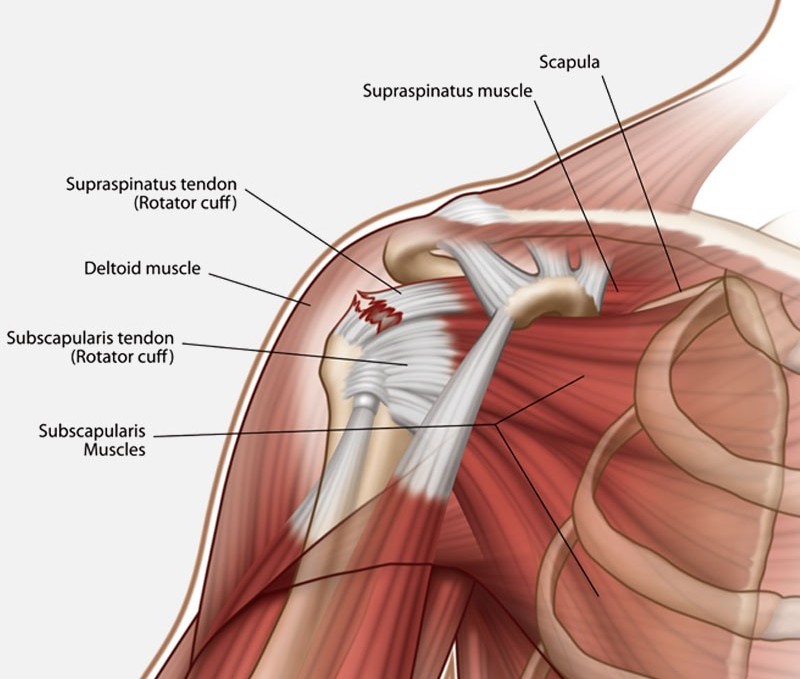SUMMARY
In this article you will learn what the MCL ligament is, the signs, symptoms and how to diagnosis of a torn MCL. You will learn how surgery is performed and how you can both prevent and recover from an MCL surgery.
What is the rotator cuff?
The rotator cuff is a group of muscles that stabilise, control, and move the shoulder joint. One of the most common causes of pain within the shoulder is associated with the rotator cuff. These include tears, calcific tendonitis, and subacromial impingement.
Given that the shoulder joint performs a wide range of motions, tears of the rotator cuff tendons are common and come about due to rapid twisting, causing over stretching the joint. There are four muscles that are collectively known as the rotator cuff. These include the subscapularis, teres minor, infraspinatus, and the supraspinatus.
The following detailed anatomical video explains the structure of the shoulder joint and the muscles that make up the rotator cuff.
Causes of torn rotator cuff tendons
Tears of the rotator cuff tendons can occur in two ways, either via trauma or repeated micro-trauma.
Trauma tears
Traumatic tears typically occur rapidly or under heavy load. Usually these injuries are caused during sports requiring lots of shoulder movement, such as baseball pitching, cricket bowling, tennis, kayaking, and swimming. Other causes include heavy lifting, falls, or motor vehicle accidents. The most commonly injured muscles in traumatic rotator cuff tear are the infraspinatus, and supraspinatus.
Repeated micro-trauma
This is the most common cause of rotator cuff tears. A repeated micro-trauma induced tear can develop over several weeks, months, or even years. This injury occurs with the tendons are repeatedly strained or pinched, causing injury to the surrounding soft tissue. As the gap between the acromion and tendons is only a few millimetres, any swelling resulting from this injury further accelerates damage to the tendons.
As people get older, degenerative tears can also develop due to poor blood circulation and/or bone spurs. With less blood supply around the rotator cuff tendons, the body’s ability to repair minor damage is reduced and this can ultimately result in a full tear. It’s not uncommon for bone spurs to develop under the acromion and when arms are elevated these spurs rub against the rotator cuff. This shoulder impingement weakens the tendon over time, increasing the risk of tears.

Signs, symptoms and diagnosis
There are different symptoms of torn rotator cuff tendons depending on the severity of the injury, including:
If the rotator cuff injury has developed suddenly, often patients will feel intense pain, arm weakness and the sensation of the shoulder ‘popping-out’. How weak the arm is will depend on the severity of the injury.
A partial tear may only cause mild shoulder pain and arm weakness, accompanied by ‘clicking’ as the arm are is elevated. Conversely, a full tear will typically present with severe pain in the shoulder and in inability to move the elbow away from the body. In some cases, due to the severity of the tear, many of the pain receptors in the shoulder are also damaged. This can reduce the degree of pain, although movement will be significantly impaired.
When a rotator cuff tendon is torn, it is no longer fully attached to the humerus head. Most cases begin with fraying due to repeated strain. As this continues a complete tear can develop suddenly, such as lifting a heavy object.
In diagnosing a rotator cuff tear medical history and a physical examination will be preformed. Doctors will assess the shoulder area for functionality, pain, and deformation. A MIR is often needed to determine the extent of the injury and how recent it is.
This video shows the how the rotator cuff can be damaged and discusses various treatment options depending on the severity of the injury.
Non-surgical treatment options for torn rotator cuffs
If the tear is small or medium, the rotator cuff tendons will generally heal successfully with appropriate physiotherapy treatment and conservative management. In these cases, non-surgical treatments will usually help to relive pain and enhance function. However, it should be noted that restoring pre-injury shoulder strength is often not possible without surgical intervention.
Non-surgical treatment options typically include a combination of the following:
Rest
Limiting elevating the affected arm and rest it in a sling may be recommended to keep the shoulder protected.
Limit movement
Any activities that cause shoulder pain should be avoided. Placing the arm in a sling is a good way to protect the shoulder.
Pain relief
Non-steroidal anti-inflammatory medication such as ibuprofin may be recommended to reduce swelling and pain.
Physical therapy and strengthening exercises
Certain exercises can be preformed to help restore movement and improve shoulder strength. These include stretches to increase motion range and improve flexibility. By strengthening the muscles around the shoulder it’s possible to reduce pain and reduce the risk of future injuries.
Steroid injection
If medications, rest, and physical therapy are ineffective, some doctors may recommend an injection of cortisone to treat severe inflammation. Cortisone works to suppress immune function, increase blood sugar, and assist with protein, carbohydrate, and fat metabolism. However, it does present risks by decreasing bone formation and should be used with caution, especially if suffering from diabetes.
Advantages of non-surgical treatments
The advantages of non-surgical treatments of torn rotator cuff is that the risks of surgery are avoided, such as:
- Permanent stiffness
- Infection
- Lengthy recovery times
- Anaesthesia complications
However, non-surgical treatments also have their limitations:
- No strength enhancement
- Tear size may still increase over time
- Extra care is needed when performing activities that require shoulder movement and strength

Torn rotator cuff surgery
Often shoulder surgeons recommend a minimum of six weeks physiotherapy before considering rotator cuff repair surgery. Surgery may be recommended if pain doesn’t improve with non-surgical treatments or if the patient is very active and relies on strong shoulder function for work or sports. Other indications that surgery may be required include:
Repairing a torn rotator cuff the tendon usually involves re-attaching the tendon to the head of the humerus. There are different method for doing these, each with advantages and disadvantages. The principal goal in every approach is to encourage the tendon to heal.
The type of procedure recommended will depend on the surgeon’s experience, the size of the tear, individual anatomy, any other shoulder problems (such as bone spur for example), and the quality of the bone and tendon tissue.
There are three techniques that are most commonly used to repair rotator cuff tears, including open, arthroscopic, and mini-open.
Open repair
This is the traditional method. An open surgical incision is made over the shoulder, often several centimetres long. The deltoid is detached to provide better access to the rotator cuff tendon. An acromioplasty is preformed if bone spurs are present. New techniques have been developed to replace the open repair method with less invasive procedures. However, this type of repair may still be preformed if the tear is complex or large, or if an additional reconstruction, such as a tendon transfer, is necessary.
Arthroscopic repair
Surgeons insert an arthroscope into the affected shoulder joint through a small incision to examine the extent of damage. The video images shown from the arthroscope are used to guide the surgeon to repair the tendon using miniature surgical instruments. This is usually an outpatient procedure and is considered the least invasive option.
This video shows an animation of how a arthroscopic repair may be performed.
Mini-open
In-depth research by Seida and colleagues has found no significant difference between open, arthroscopic, and mini-open types of surgery in terms of how well they restore shoulder function1. Nevertheless, patients often recover faster from arthroscopic surgery because it is less invasive. Some other key findings of Seida and colleagues included:
There can be some complications associated with rotator cuff repair surgery. In addition to the general risks associated with surgery, some patients may experience nerve injury, permanent stiffness, loss of motion, infections, deltoid detachment, and tendon re-tears. However, most of these risks can be minimised by following appropriate rehabilitation management techniques.

Prevention and recovery
Everyday wear and tear will promote changes in and around the shoulder joint and these alterations are difficult to prevent. However, is possible to minimise the risk of rotator cuff injuries:
Strength & Flexibility
Perform daily exercises that support strength and flexibility of the shoulder.
Posture
Maintain good posture and avoid lifting heavy objects.
Preventive Screening
If actively participating in contact sports, it’s recommended to undertake pre-season screening by an experienced physiotherapist to assess sport-specific technique, flexibility, core-stability, rotator cuff control, and general strength. This can help to identify any risk areas and apply appropriate management.
Avoid
Avoid activities that involve elevating arms above the head or out to the side for extended time periods, such as painting ceilings for example. If these activities must be performed, it’s important to take frequent breaks and ice the shoulder accordingly.
Recovery times following rotator cuff injuries can be variable depending on the extent of the injury. Usually rehabilitation will take approximately six months to regain shoulder strength, function and motion. However, rarely is it possible to regain the same range of abilities present pre-injury.
Usually physical therapy for shoulder rehabilitation will occur over three distinct phases:
Phase 1 - Immobilisation
To protect the tendon and allow it to heal the arm will be placed in a sling for the first four to six weeks with minimal use of the arm. How long it must remain in the sling will depend on the extent of the injury.
Phase 2 - Passive exercise
Once the tendon has healed, passive exercises are necessary to help strengthen the weakened muscles. These exercises usually take place within four to six weeks of surgery and are done with the aid and guidance of a physical therapist.
Phase 3 - Active exercise
After approximately four to six weeks of passive exercise patients should be able to start strengthen the muscles in their shoulder without the aid of a physical therapist. This is a gradual process and must not be rushed to avoid re-injuring the tendons. After eight to twelve weeks a strengthening exercise will be recommended.
While complete recovery will take several months, most people have adequate strength and a good function range of motion four to six weeks after surgery.
This video shows ten easy exercises to help strengthen the rotator cuff and support a strong shoulder.
Nutrients supporting ligament recovery
With any shoulder injury it’s important to rest and give the body time to heal. In addition to following the advice of a physiotherapist and/or doctor, paying close attention to diet can also help to support recovery.
Certain nutrients will assist the body to heal faster and help to strengthen the muscles and tendons. Vitamin C, omega-3 fatty acids, copper, and zinc are particularly important for reducing inflammation and accelerating healing. Antioxidant rich foods, such as fresh fruits and vegetables, will reduce the oxidative stress on the rotator cuff and surrounding structures. This will also help to improve the healing processes.
In addition to eating nutrient rich foods, there are a range of health supplements that can also help. By regularly taking a quality supplement the body will receive a boost of nutrients that assist in supporting the healing processes.
Bibliography
- Seida J, Schouten J, Mousavi S, Tjosvold L, Vandermeer B, Milne A, Bond K, Hartling L, LeBlanc C, Sheps D. (2010). Comparative Effectiveness of Nonoperative and Operative Treatment for Rotator Cuff Tears. Comparative Effectiveness Review No. 22. (Prepared by the University of Alberta Evidence-based Practice Center under Contract No. 290-02-0023.) AHRQ Publication No. 10-EHC050. Rockville, MD: Agency for Healthcare Research and Quality. Available at: www.effectivehealthcare.ahrq.gov/reports/final.cfm.




